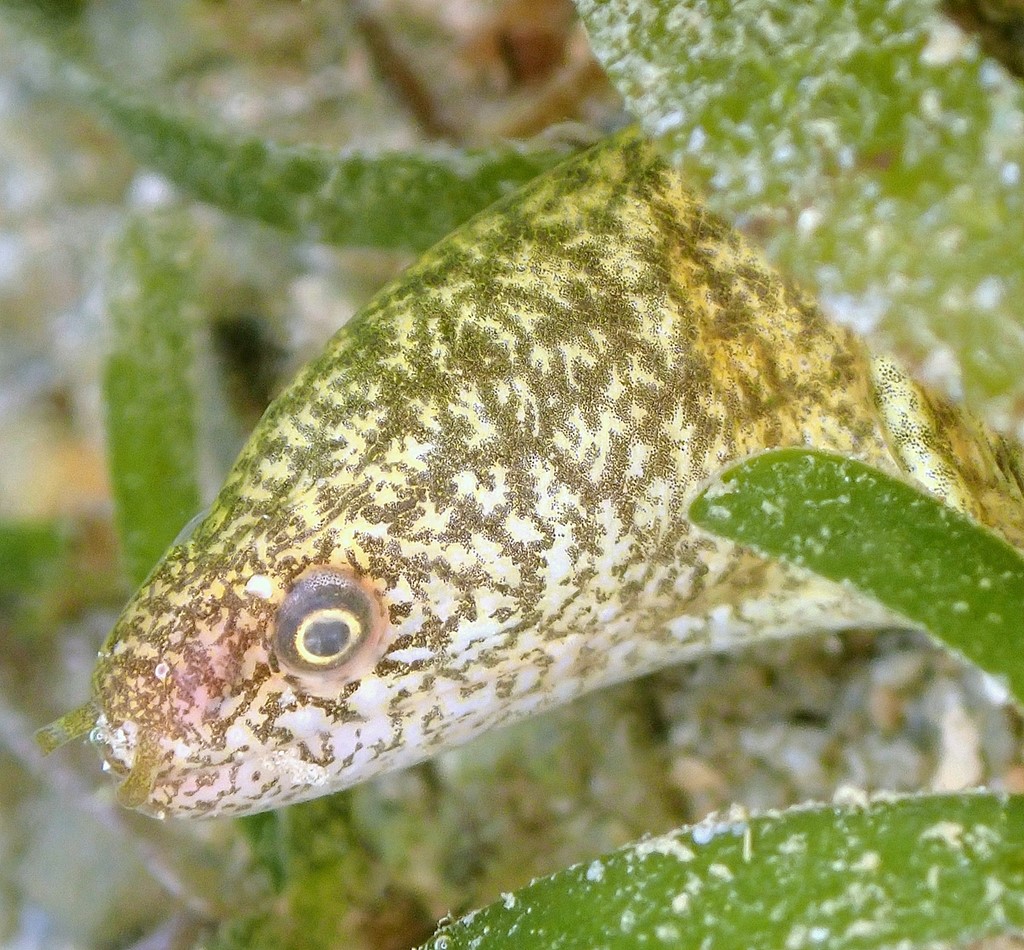GYMNOTHORAX RICHARDSONII - (BLEEKER, 1852)
Picture courtesy of: Amaury Durbano
Actinopterygii (Gigaclass) > Actinopteri (Class) > Teleostei (Subclass) > Elopomorpha (Superorder) > Anguilliformes (Order) > Muraenoidei (Suborder) > Muraenidae (Family) > Muraeninae (Subfamily) > Gymnothorax (Genus)
Anguille morel, Little moray, Richardson's moray, Spotted-lip moray, Spotted-lip moray, Spikkellip-bontpaling, Moba-utsubo, モバウツボ李氏裸胸鯙, 异纹裸胸鳝,
Synonymes
Gymnothorax richardsoni (Bleeker, 1852)
Gymnothorax richarsonii (Bleeker, 1852)
Lycodontis richardsoni (Bleeker, 1852)
Muraena ceramensis (Bleeker, 1852)
Muraena chrysops (Kaup, 1857)
Muraena diplodon (Peters, 1855)
Muraena florisiana (Bleeker, 1854)
Muraena modesta (Kaup, 1859)
Muraena richardsonii (Bleeker, 1852)
Muraena scoliodon (Bleeker, 1852)
Muraena troschelii (Bleeker, 1852)
Muraena venosa (Kaup, 1857)
Muraena vermicularis (Peters, 1855)
Thyrsoidea multifasciata (Kaup, 1857)
-------------------------
Description
Vertebrae predorsal: 7-11 (usually: 9), preanal: 46-52 (usually: 50), total: 112-117 (usually: 115). Dorsal fin origin above or just behind gill openings. Preanal length: 1.9-2.3 in TL, head long: 6.5-8.5 in TL, body depth at gill opening: 14-24 in TL, and body depth at anus: 15-23 in TL. Snout length: 5.2-8.5 in HL, upper jaw: 2.4-3.3 in HL, and eye diameter: 7.8-16.0 in HL. Teeth moderate and stout, no long canines; Adult males with fewer teeth than juveniles and females; Intermaxillary teeth in 3 rows, with 2-4 short median teeth in females (none in males); Maxillary teeth biserial in juveniles and females, uniserial in males; Vomerine teeth biserial or staggered; Dentary teeth uniserial. Max. length: 34.0 cm TL. Depth range: 1 - 15 m.
Actinopterygii (Gigaclass) > Actinopteri (Class) > Teleostei (Subclass) > Elopomorpha (Superorder) > Anguilliformes (Order) > Muraenoidei (Suborder) > Muraenidae (Family) > Muraeninae (Subfamily) > Gymnothorax (Genus)
Anguille morel, Little moray, Richardson's moray, Spotted-lip moray, Spotted-lip moray, Spikkellip-bontpaling, Moba-utsubo, モバウツボ李氏裸胸鯙, 异纹裸胸鳝,
Synonymes
Gymnothorax richardsoni (Bleeker, 1852)
Gymnothorax richarsonii (Bleeker, 1852)
Lycodontis richardsoni (Bleeker, 1852)
Muraena ceramensis (Bleeker, 1852)
Muraena chrysops (Kaup, 1857)
Muraena diplodon (Peters, 1855)
Muraena florisiana (Bleeker, 1854)
Muraena modesta (Kaup, 1859)
Muraena richardsonii (Bleeker, 1852)
Muraena scoliodon (Bleeker, 1852)
Muraena troschelii (Bleeker, 1852)
Muraena venosa (Kaup, 1857)
Muraena vermicularis (Peters, 1855)
Thyrsoidea multifasciata (Kaup, 1857)
-------------------------
Description
Vertebrae predorsal: 7-11 (usually: 9), preanal: 46-52 (usually: 50), total: 112-117 (usually: 115). Dorsal fin origin above or just behind gill openings. Preanal length: 1.9-2.3 in TL, head long: 6.5-8.5 in TL, body depth at gill opening: 14-24 in TL, and body depth at anus: 15-23 in TL. Snout length: 5.2-8.5 in HL, upper jaw: 2.4-3.3 in HL, and eye diameter: 7.8-16.0 in HL. Teeth moderate and stout, no long canines; Adult males with fewer teeth than juveniles and females; Intermaxillary teeth in 3 rows, with 2-4 short median teeth in females (none in males); Maxillary teeth biserial in juveniles and females, uniserial in males; Vomerine teeth biserial or staggered; Dentary teeth uniserial. Max. length: 34.0 cm TL. Depth range: 1 - 15 m.
MVF 9/50/115.
Color
Head, body and tail with fine greyish reticulations on pale background; Jaw pores in conspicuous white areas.
Etymology
Gymnothorax: from Greek, gymnos = naked + from Greek, thorax, -akos = breast. The genus was created in 1795 by Bloch who indicated: "The fishes of this genus are recognized by the fact that they have no pectoral fins". This characteristic is one of the main marks of the genus, allowing to distinguish it from the eels in which Linnaeus classified the moray eels. The name of the genus thus refers explicitly to the absence of pectoral fins = chest without fins.
richardsonii: in honor of Scottish surgeon-naturalist John Richardson (1787-1865), for his contributions to the knowledge of muraenid eels.
Original description: Muraena richardsonii Bleeker, 1852 - Type locality: Wahai, northern Ceram and Padang, western Sumatra, Indonesia.
Distribution
Indo-West Pacific: East Africa, Socotra (Yemen), Seychelles, Mayotte (France), Madagascar and Mascarenes (Mauritius), east to Society Islands (French Polynesia), north to Ryukyu Islands and Ogasawara Islands (Japan), south to New Caledonia and Cook Islands.
Biology
Inhabits shallow rubble lagoons and reef flats, often under large, loose dead coral pieces and rubble. Feeds on small fishes and crustaceans. Solitary.
Last update: 28, April 2024
Color
Head, body and tail with fine greyish reticulations on pale background; Jaw pores in conspicuous white areas.
Etymology
Gymnothorax: from Greek, gymnos = naked + from Greek, thorax, -akos = breast. The genus was created in 1795 by Bloch who indicated: "The fishes of this genus are recognized by the fact that they have no pectoral fins". This characteristic is one of the main marks of the genus, allowing to distinguish it from the eels in which Linnaeus classified the moray eels. The name of the genus thus refers explicitly to the absence of pectoral fins = chest without fins.
richardsonii: in honor of Scottish surgeon-naturalist John Richardson (1787-1865), for his contributions to the knowledge of muraenid eels.
Original description: Muraena richardsonii Bleeker, 1852 - Type locality: Wahai, northern Ceram and Padang, western Sumatra, Indonesia.
Distribution
Indo-West Pacific: East Africa, Socotra (Yemen), Seychelles, Mayotte (France), Madagascar and Mascarenes (Mauritius), east to Society Islands (French Polynesia), north to Ryukyu Islands and Ogasawara Islands (Japan), south to New Caledonia and Cook Islands.
Biology
Inhabits shallow rubble lagoons and reef flats, often under large, loose dead coral pieces and rubble. Feeds on small fishes and crustaceans. Solitary.
Last update: 28, April 2024
